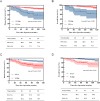The Effect of Systemic Immune-Inflammatory Index (SII) and Prognostic Nutritional Index (PNI) in Early Gastric Cancer
- PMID: 39654858
- PMCID: PMC11625636
- DOI: 10.2147/JIR.S499094
The Effect of Systemic Immune-Inflammatory Index (SII) and Prognostic Nutritional Index (PNI) in Early Gastric Cancer
Abstract
Background: In recent years, the systemic immune-inflammatory index (SII) and prognostic nutritional index (PNI) have been considered potential predictors of survival outcomes in various solid tumors, including gastric cancer. However, there is a notable lack of research focusing on their prognostic implications specifically in the early stage of gastric cancer. This study aims to investigate the prognostic indicators of early gastric cancer (EGC), including neutrophil-to-lymphocyte ratio (NLR), platelet-to-lymphocyte ratio (PLR), SII, PNI, and lymph node metastasis (LNM).
Methods: In this retrospective analysis, we examined 490 patients diagnosed with EGC (pT1Nx). The peripheral blood indices of interest were SII, PNI, PLR, and NLR. The receiver operating characteristic (ROC) curves and the area under the ROC curve (AUC) were used to determine optimal cutoff values and prognostic efficacy for each parameter. Additionally, Kaplan-Meier survival curves and multivariate Cox regression models were utilized to delineate independent prognostic factors.
Results: The optimal cutoff values for SII and PNI were determined as 613.05 and 42.21, respectively. Patients in the low SII (SII-L) group demonstrated significantly higher 5-year Disease-Free Survival (DFS) and Overall Survival (OS) rates of 94.7% and 96.2%, compared to the high SII (SII-H) group (DFS: 78.7%; OS: 81.9%), with both differences proving statistically significant (P < 0.001, P < 0.001). Similarly, patients in the high PNI (PNI-H) group showed superior 5-year DFS (93.3%) and OS rates (95.1%) versus the low PNI (PNI-L) group (DFS: 71.4%; OS: 74.3%), also demonstrating statistical significance (P < 0.001, P < 0.001). Multivariate analysis identified SII, PNI, and LNM as independent prognostic factors for EGC. A combined analysis of SII, PNI, and LNM yielded a C-index of 0.723 (P = 0.008).
Conclusion: SII, PNI, and LNM are effective markers for predicting the survival outcomes of patients undergoing radical gastrectomy for EGC.
Keywords: early gastric cancer; lymph node metastasis; prognosis; prognostic nutritional index; systemic inflammatory response index.
© 2024 Jing et al.
Conflict of interest statement
The authors report no conflict of interest in this work.
Figures





Similar articles
-
The Relationship Between Preoperative Systemic Immune Inflammation Index and Prognostic Nutritional Index and the Prognosis of Patients With Alveolar Hydatid Disease.Front Immunol. 2021 Jun 24;12:691364. doi: 10.3389/fimmu.2021.691364. eCollection 2021. Front Immunol. 2021. PMID: 34248983 Free PMC article.
-
Preoperative Systemic Immune-Inflammation Index (SII) as a Superior Predictor of Long-Term Survival Outcome in Patients With Stage I-II Gastric Cancer After Radical Surgery.Front Oncol. 2022 Feb 28;12:829689. doi: 10.3389/fonc.2022.829689. eCollection 2022. Front Oncol. 2022. PMID: 35296020 Free PMC article.
-
Utility of prognostic nutritional index and systemic immune-inflammation index in oral cancer treatment.BMC Cancer. 2022 Apr 7;22(1):368. doi: 10.1186/s12885-022-09439-x. BMC Cancer. 2022. PMID: 35392843 Free PMC article.
-
Predictive value of preoperative L3-SMI, AGR, and PNI for overall survival in patients undergoing radical gastrectomy for gastric cancer.Zhong Nan Da Xue Xue Bao Yi Xue Ban. 2025 Feb 28;50(2):204-214. doi: 10.11817/j.issn.1672-7347.2025.240521. Zhong Nan Da Xue Xue Bao Yi Xue Ban. 2025. PMID: 40523763 Chinese, English.
-
Predictive value of preoperative systemic immune-inflammation index and prognostic nutrition index in patients with epithelial ovarian cancer.J Ovarian Res. 2025 Mar 7;18(1):45. doi: 10.1186/s13048-025-01631-4. J Ovarian Res. 2025. PMID: 40055764 Free PMC article. Review.
Cited by
-
A Prognostic Nutritional Index-Based Nomogram to Predict Breast Cancer Metastasis: A Retrospective Cohort Validation.Breast Cancer (Dove Med Press). 2025 Jun 10;17:497-510. doi: 10.2147/BCTT.S523001. eCollection 2025. Breast Cancer (Dove Med Press). 2025. PMID: 40524763 Free PMC article.
-
Prognostic Value of Inflammatory Indices in Papillary Gastric Carcinoma with Different Proportions of Papillary Components.J Inflamm Res. 2025 Jul 15;18:9243-9259. doi: 10.2147/JIR.S532396. eCollection 2025. J Inflamm Res. 2025. PMID: 40687144 Free PMC article.
-
Prognostic significance of systemic immune-inflammation index in hepatocellular carcinoma: a meta-analysis.Clin Transl Oncol. 2025 Aug 19. doi: 10.1007/s12094-025-04028-3. Online ahead of print. Clin Transl Oncol. 2025. PMID: 40828354 Review.
-
Prognostic value of prognostic nutritional index in patients with nasopharyngeal carcinoma treated with endostar and concurrent chemoradiotherapy.Support Care Cancer. 2025 Feb 26;33(3):226. doi: 10.1007/s00520-025-09280-5. Support Care Cancer. 2025. PMID: 40011250
-
An Interpretable Machine Learning Model Based on Inflammatory-Nutritional Biomarkers for Predicting Metachronous Liver Metastases After Colorectal Cancer Surgery.Biomedicines. 2025 Jul 12;13(7):1706. doi: 10.3390/biomedicines13071706. Biomedicines. 2025. PMID: 40722777 Free PMC article.
References
-
- Miao RL, Li Z, Ji J. Current treatment status and trends of early gastric cancer in China: analyzed based on the data of China Gastrointestinal Cancer Surgery Union. Chinese J Pract Sur. 2019;39(05):419–423. doi:10.19538/j.cjps.issn1005-2208.2019.05.03 - DOI
LinkOut - more resources
Full Text Sources

